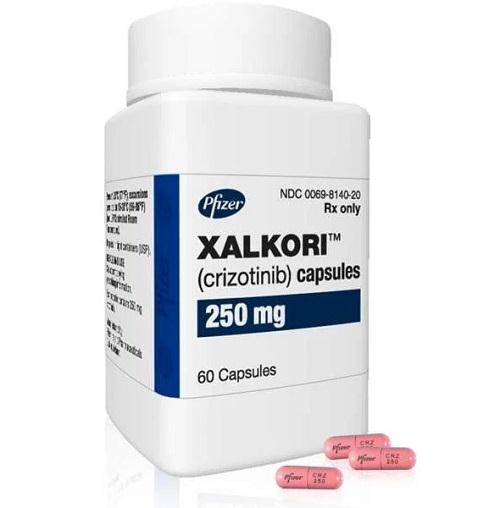Crizotinib Chemische Eigenschaften,Einsatz,Produktion Methoden
Beschreibung
Crizotinib is an oral ALK/ROS1/MET/RON inhibitor approved by the U.S. Food and Drug Administration. Crizotinib is not only used for the treatment of ALK- or ROS1-positive metastatic non-small cell lung cancer (NSCLC), but also for the treatment of adult and paediatric patients 1 year of age and older with unresectable, relapsed or refractory inflammatory anaplastic lymphoma kinase (ALK)-positive interstitial myofibroblastic tumours (IMT). In addition, crizotinib has preclinical efficacy in the Philadelphia-chromosome negative myeloproliferative neoplasms (MPNs) patient cells, JAK2 mutant cell lines, and JAK2 mutant mouse models. Crizotinib is recommended for the treatment of patients with MPN, particularly in the setting of JAK inhibitor resistance
[1].

Chemische Eigenschaften
Crizotinib is a white to pale-yellow powder with a pKa of 9.4 (piperidinium cation) and 5.6 (pyridinium cation). The solubility of crizotinib in aqueous media decreases over the range pH 1.6 to pH 8.2 from greater than 10 mg/mL to less than 0.1 mg/mL. The log of the distribution coefficient (octanol/water) at pH 7.4 is 1.65.
Verwenden
Crizotinib is a potent and selective dual inhibitor of mesenchymal-epithelial transition factor (c-MET) kinase and anaplastic lymphoma kinase (ALK). Crizotinib is a potential antitumor agent. In August 2011, the United States FDA approved crizotinib for the treatment of anaplastic lymphoma kinase (ALK) rearranged non-small-cell lung cancer (NSCLC).
Indications
Crizotinib (Xalkori(R), Pfizer), approved in 2011, was the first approved inhibitor targeting anaplastic lymphoma kinase (ALK). ROS protooncogene 1-encoded kinase (ROS1) of the tyrosine kinase insulin receptor class and MET proto-oncogene-encoded kinase of the hepatocyte growth factor receptor (HGFR) class are other kinases targeted by crizotinib.When approved in 2011, crizotinib was the first drug specifically targeting NSCLC patients. However, resistance to crizotinib was usually observed in approximately 8 months after initial application and more than half of crizotinib-treated patients experienced gastrointestinal side effects. In 2016,crizotinib was additionally approved for ROS1-positive NSCLC by FDA.
Definition
ChEBI: Crizotinib is a 3-[1-(2,6-dichloro-3-fluorophenyl)ethoxy]-5-[1-(piperidin-4-yl)pyrazol-4-yl]pyridin-2-amine that has R configuration at the chiral centre. The active enantiomer, it acts as a kinase inhibitor and is used for the treatment of patients with locally advanced or metastatic non-small cell lung cancer (NSCLC) It has a role as an antineoplastic agent, a biomarker and an EC 2.7.10.1 (receptor protein-tyrosine kinase) inhibitor. It is an enantiomer of an ent-crizotinib.
Allgemeine Beschreibung
Class: receptor tyrosine kinase; Treatment: NSCLC; Oral bioavailability = 43%; Elimination half-life = 42 h; Protein binding = 90%
Clinical Use
More recent studies have shown that patients with MET amplification and no ALK rearrangement treated with crizotinib have responded well in NSCLC and squamous cell lung carcinoma.
Crizotinib is a potent and selective mesenchymal epithelial
transition factor/anaplastic lymphoma kinase (cMET/ALK) inhibitor. Marketed under the brand name Xalkori, crizotinib was discovered and developed by Pfizer and is approved for the treatment
of advanced or metastatic non-small cell lung cancer (NSCLC)
that is caused by the echinoderm microtubule associated proteinlike
4 (EML4) mutation of ALK. Crizotinib is also undergoing
clinical evaluation against additional cancers which express the
ALK mutation, such as advanced disseminated anaplastic large-cell
lymphoma and neuroblastoma.
target
Primary targets: ALK/ROS1/MET
Mode of action
Crizotinib is an inhibitor of receptor tyrosine kinases including ALK, Hepatocyte Growth Factor Receptor (HGFR, c-Met), and Recepteur d'Origine Nantais (RON). Translocations can affect the ALK gene resulting in the expression of oncogenic fusion proteins. The formation of ALK fusion proteins results in the activation and dysregulation of the gene's expression and signaling, which can contribute to increased cell proliferation and survival in tumors expressing these proteins. Crizotinib demonstrates concentration-dependent inhibition of ALK and c-Met phosphorylation in cell-based assays using tumor cell lines, and also demonstrates antitumor activity in mice bearing tumor xenografts that express EML4-or NPM-ALK fusion proteins or c-Met.Crizotinib is a multitargeted small molecule tyrosine kinase inhibitor, which had been originally developed as an inhibitor of the mesenchymal epithelial transition growth factor (c-MET); it is also a potent inhibitor of ALK phosphorylation and signal transduction. This inhibition is associated with G1-S phase cell cycle arrest and induction of apoptosis in positive cells in vitro and in vivo. Crizotinib also inhibits the related ROS1 receptor tyrosine kinase.
https://www.ncbi.nlm.nih.gov/pmc/articles/PMC3876666/
Crizotinib Upstream-Materialien And Downstream Produkte
Upstream-Materialien
Downstream Produkte

